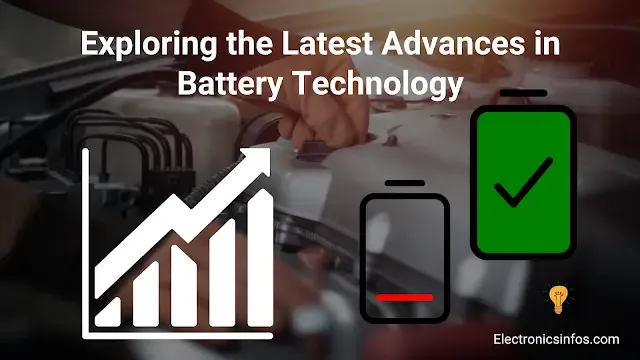Exploring the Latest Advances in Battery Technology 2024
Battery technology has been advancing rapidly in recent years.These are new breakthroughs that promise longer battery life, faster charging times, and safer operation.
In this article, we will explore the latest advancements in battery technology. Battery technology is an essential component of modern society. it is used in many applications including powering everything from electric vehicles to smartphones and laptops.
In recent years, there have been significant advances in battery technology that are improving their performance and reducing their impact on the environment.
Recent advancements in Battery Technology
- solid-state batteries
- silicon anodes
- lithium-sulfur batteries
Recent Advancement
One of the most significant recent advancements in battery technology is the development of solid-state batteries.
In traditional lithium-ion batteries, A liquid electrolyte is used to transport ions between the electrodes. In solid-state batteries, a solid electrolyte is used as an electrode.
This makes them safer and more stable than traditional batteries.
What are Solid-state batteries?
Solid-state batteries are a type of battery technology that uses solid electrodes and a solid electrolyte instead of a liquid electrolyte.
Key Features of Solid-State Batteries
- Solid Electrolytes
- Higher Energy Density
- Enhanced Safety
- Longer Lifespan
- Faster Charging
Solid Electrolytes
Solid electrolytes can be made from a variety of materials including ceramics, sulfides, and polymers.Higher Energy Density
Solid-state batteries store more energy in the same amount of space as compared to lithium-ion batteries.
Enhanced Safety
The absence of flammable liquid electrolytes makes solid-state batteries safer.
Longer Lifespan
Solid-state batteries generally have a better life cycle.Faster Charging
They can support faster charging speeds due to their higher ionic conductivity.Applications of Solid State Batteries
Solid-state batteries are used in various applications, including- The automotive industry is particularly interested in solid-state batteries due to their potential to provide longer driving ranges.
- Enhanced safety and energy density make solid-state batteries attractive for smartphones, laptops, and other portable devices.
- They are also considered for use in grid storage solutions.
Silicon Anodes: Recent Advancement
Another recent advancement in battery technology is the use of silicon anodes. Traditional lithium-ion batteries use graphite anodes, which have a limited capacity for storing lithium ions. Silicon anodes Can store up to ten times more lithium ions.
Pro of Silicon Anodes
- High Capacity
- Abundance
- Increased Energy Density
- Potential for Fast Charging
High Capacity
Abundance
Increased Energy Density
Potential for Fast Charging
Cons Of Silicon Anodes
- Silicon anodes experience significant volume changes (up to 300%) during the insertion and delithiation extraction of lithium ions. This expansion and contraction can cause mechanical stress, cracking, and pulverization of the silicon particles.
- The repeated volume changes can cause the silicon particles to lose electrical contact with the current collector. This degradation reduces the overall conductivity of the battery.
- The mechanical instability caused by volume changes can lead to continuous breaking and reforming of the SEI layer.it is a protective film that forms on the anode's surface. This process consumes lithium ions and reduces the coulombic efficiency.
- Maintaining cycling stability is a major challenge for silicon anodes. The mechanical and chemical degradation processes contribute to poor cycling performance.
Lithium-sulfur batteries: Recent Advancement
Lithium-sulfur batteries are Another recent advancement in battery technology. They offer even higher energy density than lithium-ion batteries.
So what do these advancements mean for consumers? In the short term, we can expect to see smartphones, laptops, and other devices with longer battery life and faster charging times.
In the longer term, we may see electric vehicles with longer ranges and faster charging times.
Key Features of Lithium-Sulfur Batteries
High Energy Density
Lithium-sulfur batteries have a specific energy of about 2,600 Wh/kg.Abundant and Low-Cost Materials
Sulfur is abundant and inexpensive, which can lead to cost savings in the production of Li-S batteries.Environmental Benefits
Sulfur is less harmful to the environment compared to the heavy metals used in other battery technologies. Lightweight Li-S batteries are generally lighter than traditional lithium-ion batteries.Role of AI and ML in Battery Optimization
Artificial intelligence (AI) and machine learning (ML) can be used to optimize battery performance by analyzing large amounts of data. Artificial intelligence makes predictions based on that data.
This can help improve battery efficiency, increase lifespan, and reduce the risk of failure.
One way that AI and ML can be used to optimize battery performance is through predictive maintenance.
By analyzing data on battery usage and performance, AI and ML algorithms can predict when a battery is likely to require maintenance. This can help prevent unexpected downtime.
AI and ML can be used through battery management systems (BMS). BMS use sensors and algorithms to monitor battery usage and performance in real-time and can adjust charging and discharging rates to optimize battery performance.
Conclusion
The power revolution in battery technology is a milestone in the evolution of energy storage. These innovations are not only enhancing the performance and safety of batteries but also making them more cost-effective.
As these next-generation batteries become commercially available they will play a pivotal role in technology. The ongoing research in this field promises greater breakthroughs in the coming years.
Frequently Asked Questions – FAQs
Are Solid-State Batteries Real?
Are Solid-State Batteries Available?
Are Solid-State Batteries Safer?
How Solid-State Batteries Work?
Solid-state batteries work similarly to traditional lithium-ion batteries. During charging, lithium ions move from the cathode through the solid electrolyte to the anode. During discharging, the ions move back from the anode to the cathode, generating electrical energy.
How Much Lighter Are Solid-State Batteries?
Who Makes Solid-State Batteries?
- QuantumScape
- Solid Power
- Toyota
- Samsung
- BMW
- Hyundai
Related Posts
Surge Protectors Vs Power Strips
Electrical Safety Training Tips
5 Battey Backup Surge Protectors
5 Best Digital Temperature Sensors



-Electronicsinfos.png)

.png)

0 Comments
please do not insert spam links